
The Oliver Hazard Perry class is a class of guided-missile frigates named after U.S. Commodore Oliver Hazard Perry, a commander noted for his role in the Battle of Lake Erie. Also known as the Perry or FFG-7 class, the warships were designed in the United States in the mid-1970s as general-purpose escort vessels inexpensive enough to be bought in large numbers to replace World War II-era destroyers and complement 1960s-era Knox-class frigates.
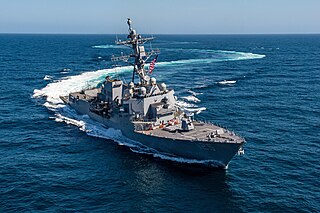
The Arleigh Burke class of guided-missile destroyers (DDGs) is a United States Navy class of destroyer centered around the Aegis Combat System and the SPY-1D multi-function passive electronically scanned array radar. The class is named for Admiral Arleigh Burke, an American destroyer officer in World War II and later Chief of Naval Operations. With an overall length of 505 to 509.5 feet, displacement ranging from 8,300 to 9,700 tons, and weaponry including over 90 missiles, the Arleigh Burke-class destroyers are larger and more heavily armed than many previous classes of guided-missile cruisers.
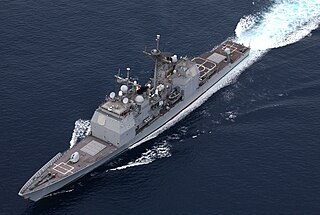
The Aegis Combat System is an American integrated naval weapons system, which uses computers and radars to track and guide weapons to destroy enemy targets. It was developed by the Missile and Surface Radar Division of RCA, and it is now produced by Lockheed Martin.
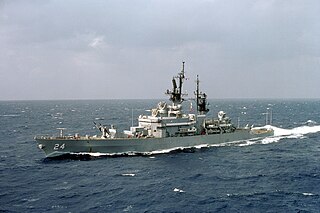
USS Reeves (DLG/CG-24), a United States Navy ship named after Admiral Joseph Mason Reeves, was a Leahy-class cruiser built by the Puget Sound Naval Shipyard, in Bremerton, Washington.

The Spruance-class destroyer was developed by the United States to replace the many World War II–built Allen M. Sumner- and Gearing-class destroyers, and was the primary destroyer built for the United States Navy during the 1970s and 1980s. It was named in honor of U.S. Navy Admiral Raymond A. Spruance, who successfully led major naval battles in the Asiatic-Pacific Theater during World War II such as the Battle of Midway and the Battle of the Philippine Sea.

The Charles F. Adams class is a ship class of 29 guided-missile destroyers (DDG) built between 1958 and 1967. Twenty-three were built for the United States Navy, three for the Royal Australian Navy, and three for the West German Bundesmarine. The design of these ships was based on that of Forrest Sherman-class destroyers, but the Charles F. Adams class were the first class designed to serve as guided-missile destroyers. 19 feet (5.8 m) of length was added to the center of the design of the Forrest Sherman class to carry the ASROC launcher. The Charles F. Adams-class were the last steam turbine-powered destroyers built for the U.S. Navy. Starting with the succeeding Spruance-class, all U.S. Navy destroyers have been powered by gas turbines. Some of the U.S. Charles F. Adams class served during the blockade of Cuba in 1962 and during the Vietnam War; those of the Royal Australian Navy served during the Vietnam War and Gulf War.

The Ticonderoga class of guided-missile cruisers is a class of warships of the United States Navy, first ordered and authorized in the 1978 fiscal year. It was originally planned as a class of destroyers. However, the increased combat capability offered by the Aegis Combat System and the passive phased array AN/SPY-1 radar, together with the capability of operating as a flagship, were used to justify the change of the classification from DDG to CG shortly before the keels were laid down for Ticonderoga and Yorktown.
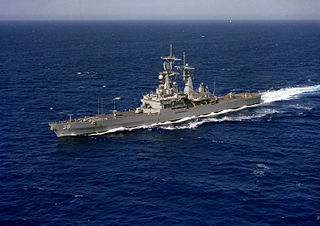
The Virginia class were four nuclear-powered, guided-missile cruisers that served in the United States Navy until the mid-to-late 1990s. The double-ended cruisers were commissioned between 1976 and 1980. They were the final class of nuclear-powered cruisers completed and the last ships ordered as Destroyer Leaders under the pre-1975 classification system.

The Kidd-class destroyers were a series of four guided-missile destroyers (DDGs) based on the Spruance class. In contrast to their predecessor's focus on anti-submarine warfare, the Kidds were designed as more advanced multipurpose ships with the addition of considerably enhanced anti-aircraft capabilities. Originally ordered for the former Imperial Iranian Navy, the contracts were canceled when the 1979 Iranian Revolution began, and the ships were completed for the United States Navy. They were decommissioned in 1999 and sold to Taiwan, where they have served in the Republic of China Navy as the Kee Lung class since 2005.

The General Dynamics RIM-24 Tartar was a medium-range naval surface-to-air missile (SAM), among the earliest SAMs to equip United States Navy ships. The Tartar was the third of the so-called "3 Ts", the three primary SAMs the Navy fielded in the 1960s and 1970s, the others being the RIM-2 Terrier and RIM-8 Talos.

The AN/SPG-51 is an American tracking / illumination fire-control radar for RIM-24 Tartar and RIM-66 Standard missiles. It is used for target tracking and Surface-to-air missile guidance as part of the Mk. 73 gun and missile director system, which is part of the Tartar Guided Missile Fire Control System.

The California class was a pair of nuclear-powered guided-missile cruisers operated by the United States Navy between 1974 and 1998. Other than their nuclear power supply and lack of helicopter hangars, ships of the California class were comparable to other guided-missile cruisers of their era, such as the Belknap class. The class was built as a follow-up to the nuclear-powered Long Beach, Bainbridge, and Truxtun classes. Like all of the nuclear cruisers, which could steam for years between refuelings, the California class was designed in part to provide high endurance escort for the navy's nuclear aircraft carriers, which were often limited in range due to their conventionally powered escorts continuously needing to be refueled.

The Tartar Guided Missile Fire Control System is an air defense system developed by the United States Navy to defend warships from air attack. Since its introduction the system has been improved and sold to several United States allies.

Leahy-class cruisers were a class of guided-missile cruisers built for the United States Navy. They were originally designated as Destroyer Leaders (DLG), but in the 1975 cruiser realignment they were reclassified as guided-missile cruisers (CG).

The AN/SPS-48 is a US naval electronically scanned array, air search three-dimensional radar system manufactured by ITT Exelis and deployed in the 1960s as the primary air search sensor for anti-aircraft warships. The deployment of the AN/SPY-1 and the end of the Cold War led to the decommissioning of many such ships, and many of these vessel's AN/SPS-48 sets were reused on aircraft carriers and amphibious ships where it is used to direct targets for air defense systems such as the Sea Sparrow and RIM-116 SAM missiles. Existing sets are being modernized under the ROAR program to AN/SPS-48G standard for better reliability and usability.

The AN/SPS-49 is a United States Navy two-dimensional, long range air search radar built by Raytheon that can provide contact bearing and range. It is a primary air-search radar for numerous ships in the U.S. fleet and in Spain, Poland, Taiwan aboard Oliver Hazard Perry-class frigates, Canada on its Halifax-class frigate and New Zealand on its Anzac-class frigates. It formerly served in a complementary role aboard Aegis cruisers with the AN/SPY-1 but the systems are currently being removed during routine upgrade with no replacement.
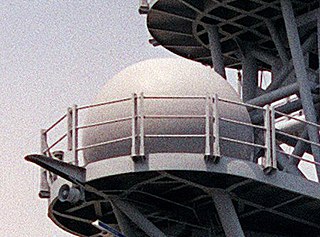
AN/SPQ-9A is a United States Navy multi-purpose surface search and fire control radar used with the Mk-86 gun fire-control system. It is a two dimensional surface-search radar, meaning it provides only range and bearing but not elevation. It is intended primarily to detect and track targets at sea level, on the surface of the water for either gun fire engagement or navigation. It can however, also detect and track low altitude air targets.

The RIM-66 Standard MR (SM-1MR/SM-2MR) is a medium-range surface-to-air missile (SAM), with a secondary role as an anti-ship missile, developed for the United States Navy (USN). A member of the Standard Missile family of weapons, the SM-1 was developed as a replacement for the RIM-2 Terrier and RIM-24 Tartar that were deployed in the 1950s on a variety of USN ships. The RIM-67 Standard (SM-1ER/SM-2ER) is an extended range version of this missile with a solid rocket booster stage.

The RIM-67 Standard ER (SM-1ER/SM-2ER) is an extended range surface-to-air missile (SAM) with a secondary anti-ship capability, originally developed for the United States Navy (USN). The RIM-67 was developed as a replacement for the RIM-8 Talos, a 1950s system deployed on a variety of USN ships, and eventually replaced the RIM-2 Terrier as well, since it was of a similar size and fitted existing Terrier launchers and magazines. The RIM-66 Standard MR was essentially the same missile without the booster stage, designed to replace the RIM-24 Tartar. The RIM-66/67 series thus became the US Navy's universal SAM system, hence the designation "Standard Missile".

The Mark 41 vertical launching system is a shipborne missile canister launching system which provides a rapid-fire launch capability against hostile threats. The vertical launching system (VLS) concept was derived from work on the Aegis Combat System.



















